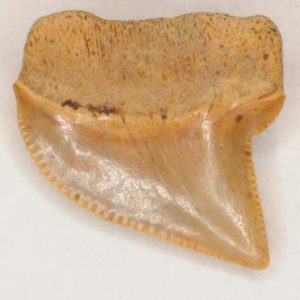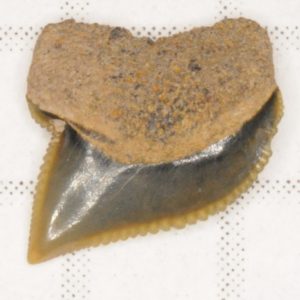NJfossils.com
"Fossils aren't a hobby, they're a lifestyle."Crow (Squalicorax “kaupi“)
Age – Late Cretaceous; Commonality – very common; Size – average: ½ inch, max – ~7/8 inch
The teeth of the crow sharks vary in shape more than any other species present here. Their teeth are flattened and normally have a greater width than length (in laterals). Crow shark teeth are also the only serrated type of shark tooth found here other than Pseudocorax. The ratio between tooth length and width gets smaller as you go further back into their mouth. They sort of don’t have an “anterior tooth” or “lateral position” or “posterior position”, such as in Scapanorhynchus teeth. It is just the tooth angle along with a couple other features that change. Anterior teeth have more of a straight shape, and posteriors are more curved distally. Crow teeth also sometimes possess small foramina on the labial side of the root. They have a cutting type of dentition.
Quotations are placed around “kaupi” because it is a paleobucket term which includes more than one species. It will likely be very difficult to determine how many “kaupi” species there really are.
The two types of Squalicorax teeth present are S. pristodontus and S. “kaupi“. S. pristodontus teeth are larger and have a wider angle in the notch on the distal part of the tooth. It also seems like S. “kaupi” is more variable than S. pristodontus.
S. “kaupi” had symphyseal teeth. The anteriormost teeth of S. “kaupi” resemble its symphyseal teeth. The symphyseals are rare and were likely disappearing from its dentition. Since their symphyseal teeth are rare, it is likely that not every S. “kaupi” individual had a symphyseal tooth file in their mouth. The symphyseal teeth are rather strange in appearance. They have a much narrower root than the usual crow teeth and can vary in shape. (Information from Steve B.)
S. pristodontus had fewer variations in tooth shape than S. “kaupi“. This likely has to do with the fact that it had fewer teeth in its jaws (the less teeth, the greater the chance they look similar to each other) than S. “kaupi“; it also has to do with the fact that “kaupi” is a paleobucket (the more species, the more variation). S. “kaupi” had a slightly smaller body size, but S. “kaupi” teeth are not smaller solely because of that reason; its jaws were only slightly smaller than that of S. pristodontus, but it had smaller teeth also because it had a higher tooth count. Both species have simplex serrations. S. pristodontus likely did not have a symphyseal tooth file.
Symphyseal Tooth
This tooth is most likely a symphyseal. There is a small chance it could be an extreme anterior tooth, but its morphology matches better with a symphyseal tooth. Symphyseal Squalicorax teeth have a lot of variation – some have one root lobe, are hook-like, and have serrations only on one side of the crown. Note the absence of a distal notch on this symphyseal.
It is possible that Squalicorax were in the process of losing their symphyseal file(s). Most sharks might not have had a symphyseal file. That would explain the rarity of Squalicorax symphyseal teeth and their variation. (Information from Steve B.)
Anterior Teeth
A nice yellow one.
This tooth is a great example of the variability of this shark. In most sharks (Scapanorhynchus is a good example) the mesial root lobe is longer than the distal one. This tooth has a larger distal root lobe.
This tooth has a markedly different morphology than the others. It has a relatively deeper distal notch and a small mesial notch. It also has a different root shape.
Lateral Teeth
Lateral teeth are broader and more distally angled. The root lobes are shorter than on the more anterior teeth.






















